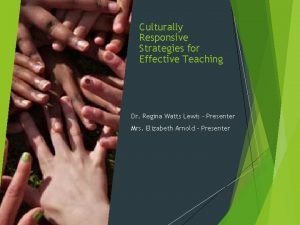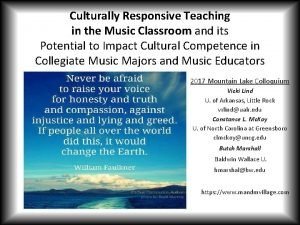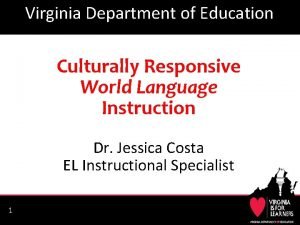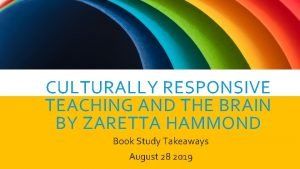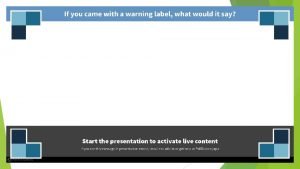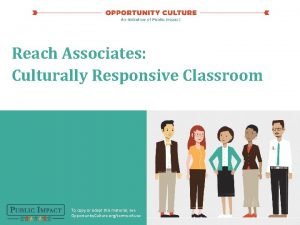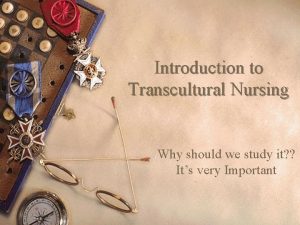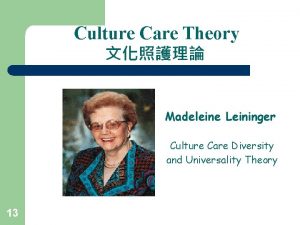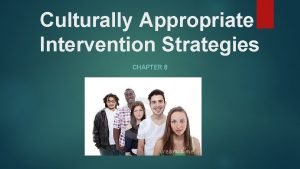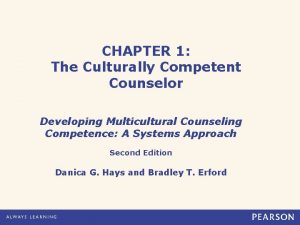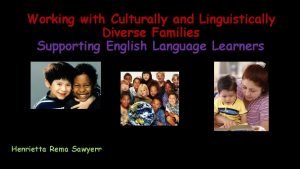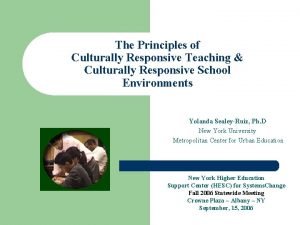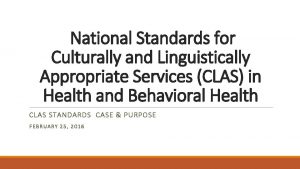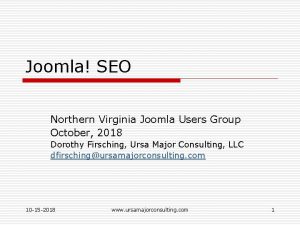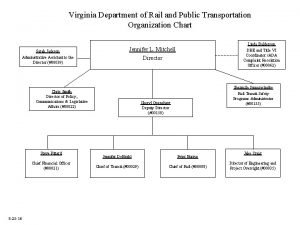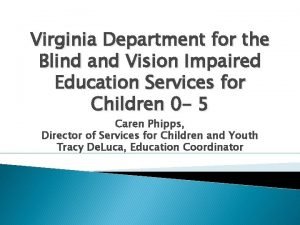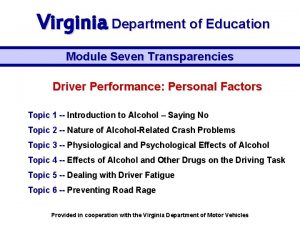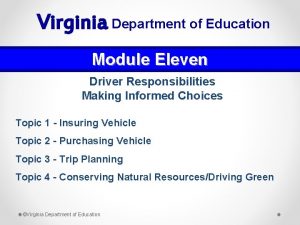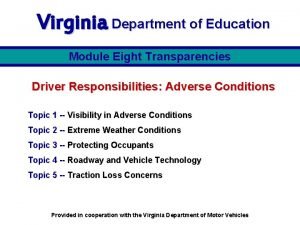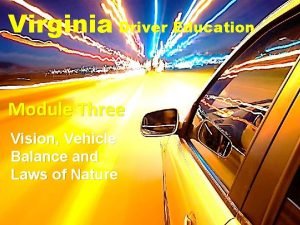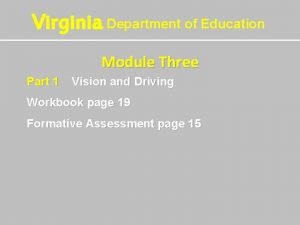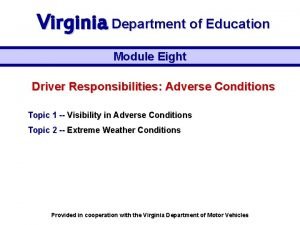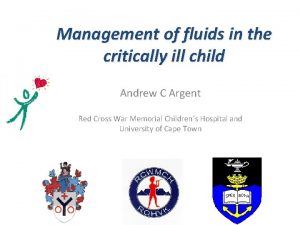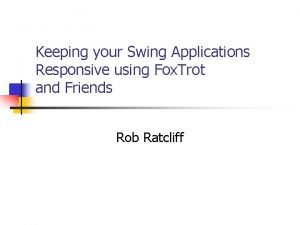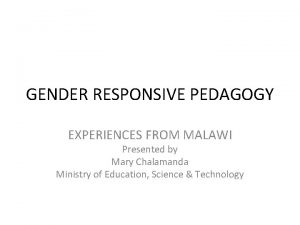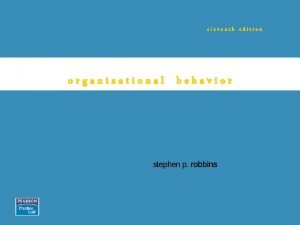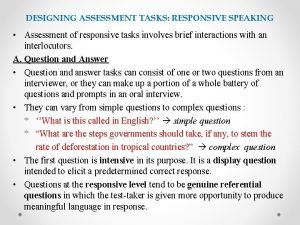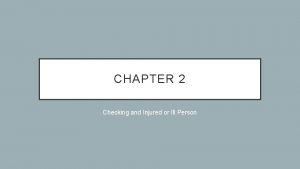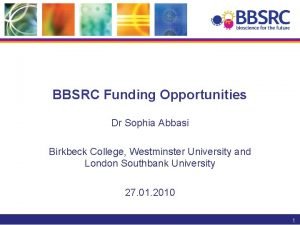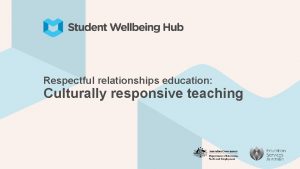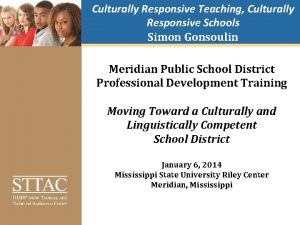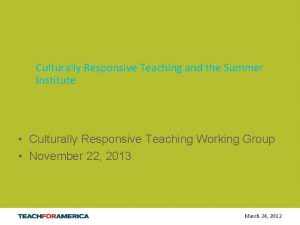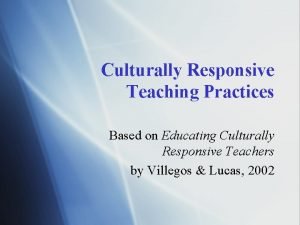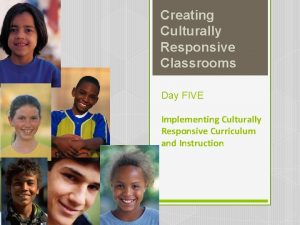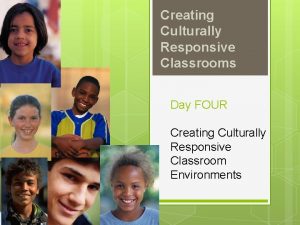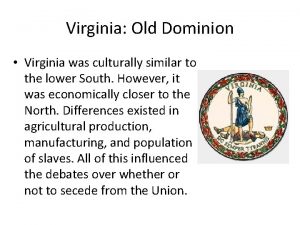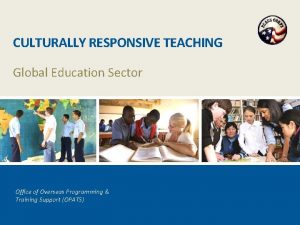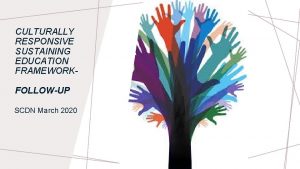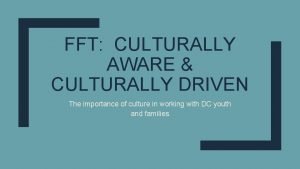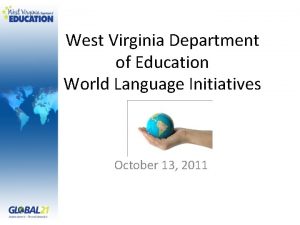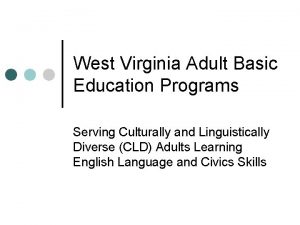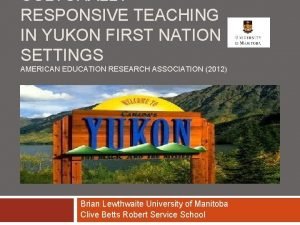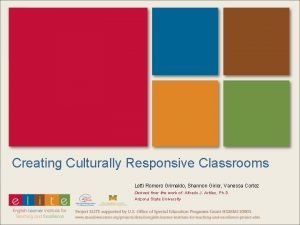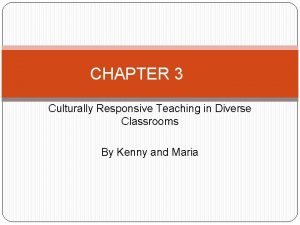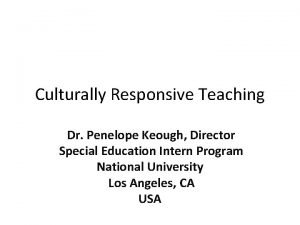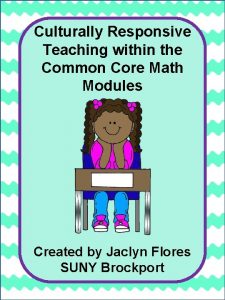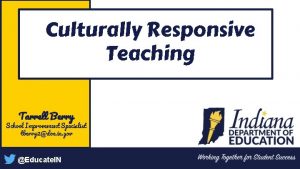Virginia Department of Education Culturally Responsive World Language


















![Sample Guiding Questions for Making Connections • • How is this [cultural aspect] the Sample Guiding Questions for Making Connections • • How is this [cultural aspect] the](https://slidetodoc.com/presentation_image_h/29da2844957ad3b7298c84ab1ec37038/image-19.jpg)















- Slides: 34

Virginia Department of Education Culturally Responsive World Language Instruction Dr. Jessica Costa EL Instructional Specialist 1

Sharing Ideas and Questions Share ideas and respond to others Pose questions to the facilitator to answer at the end of the presentation 2

Logistics This session is being recorded and closed captioning is provided. The recording and slides will be available after the webinar. This webinar will last approximately one hour and you will receive a follow up email for your documentation. You will need to speak with your division regarding the awarding of professional points. 3

Webinar Goals and Sequence • • 4 Connect to current practice Describe impacts of culture on learning Identify components of culturally responsive instruction Leave equipped with strategies for enhancing culturally responsive World Language Instruction

Goal 1 Connect to current practice 5

Culturally Responsive Practice Intentional culturally responsive teaching means that teachers learn and use the student’s culture to help children access knowledge, practice skills and demonstrate knowledge. Instead of ignoring culture or pretending that culture has no affect on how students learn, culturally responsive teaching takes the opposite tact, it seeks to thoroughly learn, affirm and validate different cultural characteristics in the classroom and uses it to have a dynamic classroom of learners. (Larry Ferlazzo, 2020) 6

Connect to Current Practice What is one culturally responsive strategy you include in your World Language instruction? “…. thoroughly learn, affirm and validate different cultural characteristics in the classroom and uses it to have a dynamic classroom of learners. ” (Larry Ferlazzo, 2020) Please type your responses in the chat box. 7

Goal 2 Describe impacts of culture on learning 8

Inclusion Activity Picture a tree. In the chat box, write a brief description or the name of the tree (10 seconds). 9

D o e s y o u r t r e e l o o k Activity Debrief and Instructional Implications l i k e m i n e ? Does yours look like mine? Does it have to? 10

Context and Perspective Matter “We don’t see things as they are, we see things as we are. ” (Anaïs Nin, Author and Diarist) Frames of Reference Mental Models 11

Another Tree Analogy: Cultural Impacts on Learning • • 12 Concept of self Definition of success Concept of justice Conversational patterns in social contexts Concepts of past and future Ordering of time Patterns of handling emotions Etc. Items on list from Understanding ESL Learners: Moving Toward Cultural Responsiveness— A Guide for Teachers Surface culture Deep culture

Culturally Responsive World Language Teachers • • • think beyond the culture they are teaching as content, and seek to learn about the cultures and identities of their students; reflect on their own culture and frame of reference; and use what they know about their students to structure lessons that engage students who have varied interests, motivations, preferred learning styles, and ways of making sense of new learning, even when those are not the same as their own. Responsive Lesson 13

Goals 3 & 4 Identify components of culturally responsive instruction Leave equipped with strategies for enhancing culturally responsive World Language Instruction 14

Components and Characteristics of CRI Culturally Relevant Curriculum Connections Affirming and Asset-Based Approaches Supportive Learning Environment 15

Culturally Relevant Curriculum Connections • • • 16 Tap into students’ prior knowledge and background experiences. Provide opportunities and supports for students to make relevant connections between the target language and culture as they share about their own languages, cultures, interests, and experiences. Display/share artifacts, pictures, and relevant materials that reflect people of all cultures positively.

Making Connections Cultural Awareness For Students: Explicit instruction and bridging activities For Teachers: Learning about Students’ Cultures Learning about new cultures and identities 17 Connecting to one’s own identity Appreciation of differences and more effective cross -cultural communication

Windows and Mirrors View into someone else’s experience. 18 • Reflects one’s own culture • Helps build identity Mirrors, Windows and Sliding Doors (Bishop, 1990)
![Sample Guiding Questions for Making Connections How is this cultural aspect the Sample Guiding Questions for Making Connections • • How is this [cultural aspect] the](https://slidetodoc.com/presentation_image_h/29da2844957ad3b7298c84ab1ec37038/image-19.jpg)
Sample Guiding Questions for Making Connections • • How is this [cultural aspect] the same as or different from my own? How can we make connections between different experiences (that honors everyone’s perspective)? Learner response options: Chat box, Flipgrid, in class pair 19 discussions, written response or graphic organizer sent by text/email

Student Identity Reflection Tool • I learn best when… • Something I do when I am frustrated and wish I had help: • It is important that my teacher know this about me: • ___ makes me nervous. ___ makes me less nervous. • I need ____ to be successful. • I prefer activities that ___. 20 Inclusive Teaching at University of Michigan

Critical Analysis of Materials Brownface • How might any images or materials situate a group of people as superior? • Do the materials authentically and positively present all people? • Are people represented as individuals as opposed to representative of a group of people/culture? 21 Brands and company information have been removed intentionally.

Reflect: Culturally Relevant Curriculum Connections Share another idea or strategy for Culturally Relevant Curriculum Connections Please type your responses in the chat box. 22

Affirming and Asset-Based Approaches • • • 23 Validate errors as part of the learning process and model vulnerability. Provide productive feedback that highlights student strengths while giving students direct information about next steps and growth opportunities. Provide empowering affirmations for students to use throughout class. Expect and support opportunities for all students to think critically and practice the target language. Celebrate successes and growth.

Teacher Language Norms • Asset-Based Language DEFICIT MINDSET: • Not responsive/Non Compliant • Illiterate • At-risk • These kids have no…/can’t • • • 24 ASSET MINDSET: • Background and perspective to learn more about • Resilient and Resourceful • My students are not yet …. . and can • I can help my students develop… Solutions-Focused Obstacles as Opportunities Focus on frustrations ≠ Productive dialogue

Affirmations Matter • • • 25 I will work to my highest ability. I can learn when I work hard and use my resources. I will preserve though challenges and focus on solutions. My mind is a muscle and I am working on its growth. I will embrace my mistakes as part of the learning process. I’ve made progress in understanding and using my target language. I am really good at ___ and can use that to learn ___. I choose to take each opportunity to speak in my target language and I’m impressed by my courage to do so.

Critical Thinking in World Language Learning • • 26 “By building on the cognitive skills students have in their L 1 and their knowledge from other disciplines, instructors can transform language classrooms into spaces of higher-order thinking and learning, even at the introductory level of instruction. ” (Modern Language Association) Focus on meaning-making and authentic communication, not linguistic accuracy

With Language Supports, World Language Students Can… Combine both language and analytic skills to: – Sequence pictures of short stories based on a reading or listening text – Complete graphic organizers to classify geographical aspects of countries – Compare two objects of study, e. g. , folktales, works of art (given sentence frames for functional, comparative language) – Predict and confirm outcomes of a simple experiment 27

Reflect: Affirming and Asset-Based Approaches Share another idea or strategy for Affirming and Asset-Based Approaches Please type your responses in the chat box. 28

Supportive Learning Environment • • • 29 Use multiple teaching approaches and strategies and provide options for assignments that match a variety of learning styles and needs. Integrate multi-modal scaffolds to make key concepts and skills explicit and accessible (e. g. , visual, kinesthetic, auditory, interactive, sentence frames, graphic organizers). Model often and allow processing time and practice before any whole group questioning. Make success criteria clear. Monitor progress toward the success criteria by circulating around the classroom/checking-in remotely. Amplify individualized instruction as needed.

Multiple Approaches and Supports Example Supports • Visuals • Information presented verbally and in writing • Graphic Organizers • Modeled Conversations • Writing frames • Conversation sentence starters • Cognate lists connected to the lesson • Peer • Cooperative Structures and Activities 30 Example Approaches • Communicative Approach: Tasks connected to thematic unit • Task-based learning: Use language authentically to complete a task • Direct Instruction/ Immersion • Total Physical Response: Connecting motion to new language • Audio-lingual model: repeating key language pieces after listening, i. e. , for affirmations

Reflect: Supportive Learning Environment Share another idea or strategy for Supportive Learning Environment Please type your responses in the chat box. 31

References and Resources for Further Exploration Clickable link 32

Disclaimer Reference within this presentation to any specific commercial or non-commercial product, process, or service by trade name, trademark, manufacturer or otherwise does not constitute or imply an endorsement, recommendation, or favoring by the Virginia Department of Education. 33

Questions? Contact Information: Dr. Jessica Costa VDOE EL Instruction Specialist jessica. costa@ doe. virginia. gov 34
 Culturally responsive vs culturally relevant
Culturally responsive vs culturally relevant Culturally responsive teaching in music education
Culturally responsive teaching in music education Vdoe culturally responsive teaching
Vdoe culturally responsive teaching Culturally responsive teaching and the brain book study
Culturally responsive teaching and the brain book study Culturally responsive classroom management
Culturally responsive classroom management Culturally responsive teaching self assessment
Culturally responsive teaching self assessment Culturally deprived definition
Culturally deprived definition Giger and davidhizar transcultural assessment model
Giger and davidhizar transcultural assessment model Culturally congruent care
Culturally congruent care Culturally appropriate intervention strategies
Culturally appropriate intervention strategies Culturally competent counselor
Culturally competent counselor Working with culturally and linguistically diverse families
Working with culturally and linguistically diverse families Culturally relevant pedagogy
Culturally relevant pedagogy National culturally and linguistically appropriate services
National culturally and linguistically appropriate services Smart seo plugin joomla
Smart seo plugin joomla Virginia department of agriculture food safety
Virginia department of agriculture food safety Virginia department of historical resources
Virginia department of historical resources Virginia department of rail and public transportation
Virginia department of rail and public transportation Virginia department for the blind and vision impaired
Virginia department for the blind and vision impaired Module 10 topic 3 drivers ed
Module 10 topic 3 drivers ed Module 7 topic 1 drivers ed
Module 7 topic 1 drivers ed Curriculum guide for driver education in virginia module 11
Curriculum guide for driver education in virginia module 11 Curriculum guide for driver education in virginia module 8
Curriculum guide for driver education in virginia module 8 Module 3 topic 4 basic maneuvering steering and braking
Module 3 topic 4 basic maneuvering steering and braking Roll drivers ed
Roll drivers ed Why are most roadways crowned?
Why are most roadways crowned? Module 7 topic 1 distracted driving
Module 7 topic 1 distracted driving Sensate focus.
Sensate focus. Fluid responsive shock
Fluid responsive shock Java swing responsive gui
Java swing responsive gui Gender responsive pedagogy
Gender responsive pedagogy Culture vs formalization
Culture vs formalization Example of responsive speaking
Example of responsive speaking Https //forms.office.com
Https //forms.office.com Bbsrc responsive mode
Bbsrc responsive mode
